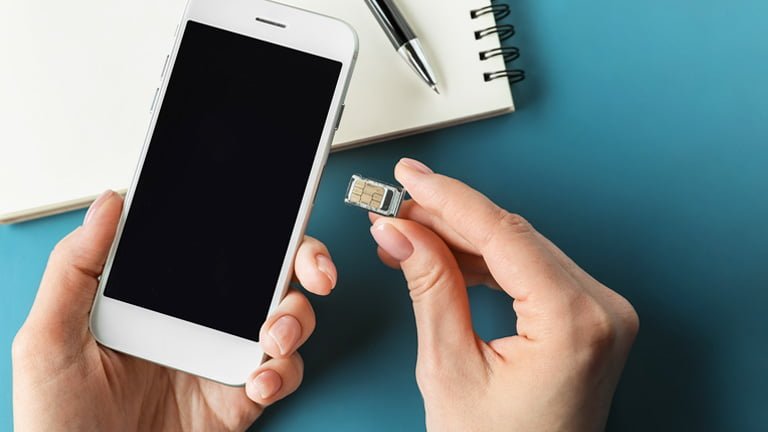
SIM cards, or Subscriber Identity Modules, are small chips that are used in mobile devices to store information about the user’s cellular service provider, phone number, and other important data. They are inserted into a mobile device and serve as the link between the device and the network, allowing users to make calls, send text messages, and access the internet. SIM cards are used in all types of mobile phones, from basic feature phones to high-end smartphones, and are an essential component for accessing cellular service. But, can SIM cards go bad?
Whether you’re upgrading to a new phone, traveling abroad, or simply switching service providers, you’ll likely need to use a SIM card to get your device up and running on the network. A SIM card and an eSIM are both used for connecting a mobile device to a cellular network, but they differ in how they store and access the necessary information. A SIM card is a physical chip that is inserted into a mobile device and contains all of the information needed to access the network. An eSIM, on the other hand, is a virtual SIM card that is stored directly on the device and can be easily activated or changed through software. eSIMs eliminate the need for a physical SIM card and allow for a more streamlined and flexible experience.
Since SIM cards can go bad or break suddenly in an emergency, for instance while traveling abroad, it is good to be prepared by knowing how can SIM cards go bad and what people should do to prevent or after SIM cards go bad.
6 Possible cases when can SIM cards go bad
Since SIM cards come with a physical card plate, there are many possible cases when SIM cards go bad, and here are the 6 most common cases that your SIM cards can be damaged.
- Water or Liquid
When a SIM card is exposed to water or liquid, it can cause corrosion and damage to the chip, which can result in a loss of service or other problems. If a SIM card is accidentally dropped in water or exposed to liquid, it should be immediately removed from the device and dried off to prevent further damage.
- Heat
Excessive heat can cause physical damage to a SIM card, causing it to deform or even melt. This can result in problems such as the inability to make or receive calls or slow data speeds. Keeping your mobile device and SIM card away from heat sources, such as direct sunlight or hot car interiors, can help prevent this type of damage.
- Bending
Bending or flexing a SIM card can cause physical damage to the chip, which can result in problems such as a loss of service or slow data speeds. When inserting or removing a SIM card, it is important to handle it carefully to prevent bending or cracking.
- Corrosion
Corrosion can occur when a SIM card is exposed to water or other elements, causing the chip to deteriorate over time. This can result in problems such as slow data speeds, loss of service, or the inability to make or receive calls. It is important to handle your SIM card carefully and keep it protected from exposure to water and other elements.
- Static Electricity
Static electricity can cause SIM cards go bad, resulting in problems such as slow data speeds, loss of service, or the inability to make or receive calls. Touching a metal object before handling your SIM card can help discharge any static electricity on your body and prevent damage to the chip.
- Other SIM card damaged factors
Dust buildup, expired support, or software issues can also contribute to SIM card problems. Keeping your SIM card and device clean, up-to-date, and free from malware can help prevent issues and ensure a smooth experience.

How do I check if my SIM card is broken?
There are several signs that reveal that your SIM cards go bad or may be broken as mentioned below. If you have difficulty using your cell phone, you should check for the following symptoms and check your SIM card for abnormalities.
Bad SIM cards symptoms for iPhone
- “No SIM Installed” or “No Service” Message
If you receive a message saying that there’s no SIM card installed or that you’re not able to access a cellular network, it could indicate that your SIM card is damaged.
- Contact List Corrupted
When your contact list is corrupted or not accessible, it may be a sign that there’s an issue with your SIM card.
- Sound Quality of Calls Goes Bad
If the sound quality of your calls suddenly decreases or becomes garbled, it could indicate a problem with your SIM card.
- Delay in Text Messages and Calls
A delay in receiving text messages or making calls could also mean that there is a problem with your SIM card.
Bad SIM cards symptoms for Samsung & Google
- Function Freeze
When your device freezes or crashes when you try to access certain functions.
- Password Authentication Messages
When you keep receiving a message asking for password authentication.
How long does a SIM Card last? When do I have to replace it?
SIM cards are designed to last for several years, but the exact lifespan of a SIM card can vary depending on several factors. Factors such as exposure to water, heat, and other elements, as well as general wear and tear, can all affect the lifespan of a SIM card.
In general, it is recommended to replace your SIM card every two to three years to ensure optimal performance and prevent potential problems such as slow data speeds, loss of service, or the inability to make or receive calls.
Additionally, if you experience any of the symptoms of a damaged SIM card, such as a “No SIM Installed” message or poor call quality, it may be a good idea to replace your SIM card even if it hasn’t reached the recommended two-to-three-year lifespan.
What should I do when my SIM card goes bad?
It’s important to take action if your SIM cards go bad to ensure that your device remains connected to the cellular network and that you have access to your important data. By following the steps below, you can diagnose and resolve any issues with your SIM card and get your device back up and running.
3 things you can try for a SIM card that doesn’t work well
- Clean Your SIM Card
If your SIM card is experiencing problems, the first step is to clean it. Dirt, dust, and other debris can interfere with the connection between the SIM card and your device, causing issues with your service. Clean your SIM card with a soft, dry cloth and make sure it’s free of any debris.
- Replace Damaged SIM card
In case cleaning the SIM card doesn’t solve the issue, you may need to replace it. If your SIM card is visibly damaged, such as bent, broken, or has scratches, it may not be functioning properly and need to be replaced.
- Check Via SIM Card Reader and Software
You may be able to recover the data using a SIM card reader and special software. It should help you recover your data by reading the information stored on the SIM card, especially if you have important information stored on your SIM card that you need to recover.
eSIM, A good alternative to the disadvantages of SIM cards
An eSIM, or embedded SIM, is a good alternative to the traditional physical SIM card that can solve many of the disadvantages of traditional SIM cards. It is a virtual SIM card that is embedded directly into a device, eliminating the need for a physical card. Hence, it offers several key benefits over traditional SIM cards, making it a popular choice for many consumers.
One of the biggest advantages of eSIMs is that they are more convenient and easier to use than traditional SIM cards. With an eSIM, you can switch carriers or change your plan without having to physically remove or replace your SIM card. This makes it way safer from being physically damaged or easier to switch carriers if you move to a new location or if you find a better plan that fits your needs.
Another benefit of eSIMs is that they are more secure than traditional SIM cards. An eSIM is embedded directly into a device, making it much harder for unauthorized users to access the data stored on the card. Therefore, it provides a higher level of security for your personal information, financial information, and other sensitive data.
Moreover, eSIMs also deliver greater flexibility and customization options. With an eSIM, you can activate multiple plans and switch between them as needed, without having to physically replace the card. This makes it easier to use multiple carriers for different purposes, such as using a separate plan for work and another for personal use.
eSIM, the optimal choice for long term instead of SIM cards
SIM cards go bad due to various factors such as exposure to water, heat, bending, corrosion, or static electricity. A damaged SIM card can result in issues such as poor sound quality of calls, delay in text messages and calls, or even the inability to access data stored on the card.
In contrast, eSIMs offer a better long-term solution as they are embedded directly into the device and eliminate the risk of physical damage. They are also more secure, convenient, and flexible than traditional SIM cards, allowing you to switch carriers or change plans without having to physically remove or replace the card. Additionally, eSIMs purchased from reliable eSIM providers like eSIM Europe, eSIM UK can be activated remotely and offer multiple plans, making it a more streamlined and customizable experience. Therefore, an eSIM is an optimal choice for those looking for a reliable and convenient mobile solution.



